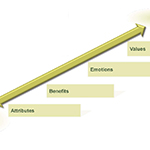Have you ever been in a meeting where it seems that everyone participating has a different frame of reference, different agenda and different way of approaching the problem? It’s not an uncommon situation. While it may not be able to address all of the problems in such a meeting, there is a structure and process for thinking about communications strategy development that has a strong history and that, with a little effort, can be understood and applied to a spectrum of marketing and communications questions.
This unifying thinking framework is called means-end, as in a means to an end. Well-grounded in academic research and marketing literature, means-end theory asserts that people make choices in specific situations in a manner that taps into four dimensions:
By understanding the essence of these four dimensions, as well as how they link to each other, we can gain insight into why people are motivated to act in certain ways. Attributes and the benefits that flow from them identify what about your concept, product, company or idea is important and relevant. This leads to emotional benefits and the personal values associated with those tangible characteristics. If we can uncover what specific deeply held personal value is triggered, then the motivation behind a category behavior can be mapped and serve as a template for strategy thinking.
Most people don’t wear their emotions on their sleeves, so a body of research approaches has developed to unveil emotions and values in a manner that allows mapping of various decision structures. Based on our experience, conducting such research is a powerful way to gain insight on a market or business situation.
Strategists can derive even more power by organizing their planning, hypothesizing, reviewing, investigating, creating, communicating and evaluating with this means-end framework in mind. We’re thrilled when we can combine means-end research with this strategy evaluation approach, because it helps us to give our clients a common frame of reference, an action agenda and a clear picture of the situation at hand—the same things that can help bring everyone together in a potentially chaotic business meeting.
Learn about how we put means-end theory into action with a variety of client case studies, and contact us for information on how means-end theory can help your organization with communications strategy development.




